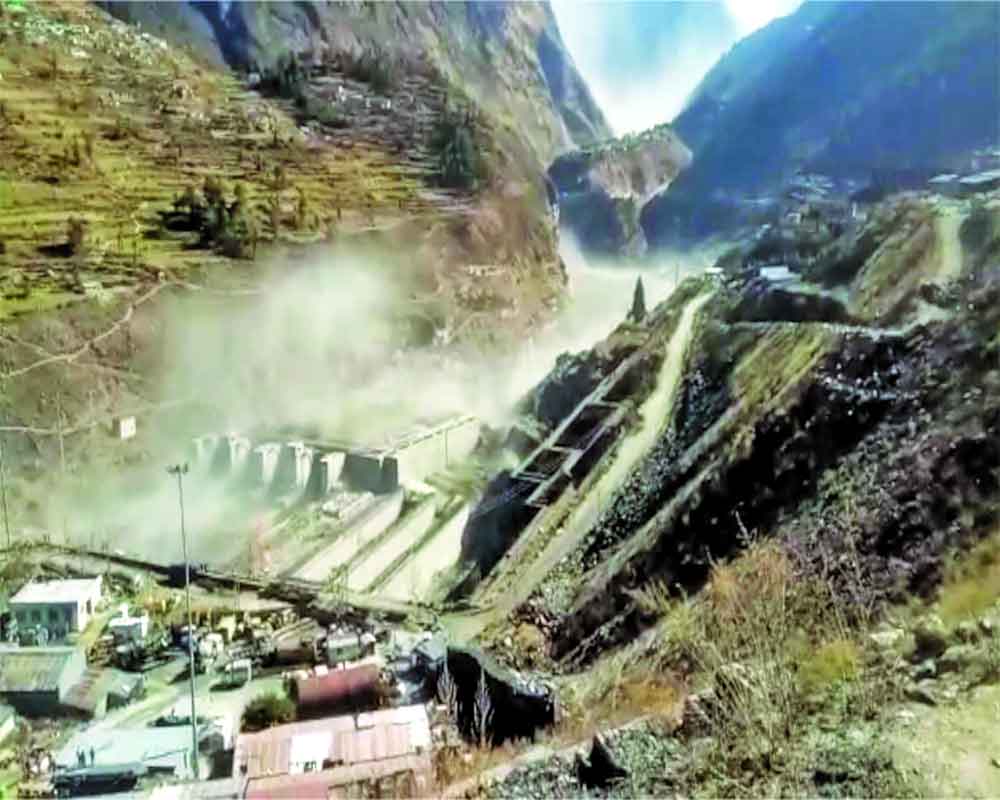Commissioning of hydro-electric projects in Uttarakhand is an ecological harakiri. Despite warnings, the NTPC project in Vishnugad was carried on
Joshimath is one of the four ‘maths’ discovered by Adi Guru Shri Sankaracharya in the 8th century AD. Situated at an altitude of 2100 metres in the Chamoli District, and has for time immemorial been the preferred halt for pilgrims while proceeding to the Char Dham Yatra of Badrinath, Kedarnath, Gangotri, and Yamunotri. This simple town home to 20,000 population, has now made the headlines with the authorities declaring the place disaster prone due to land subsidence. Nearly 700 commercial, residential and army structures in the town have developed cracks due to rapidly sinking land. Thankfully there has been no loss of life reported till date although 60 families have been evacuated from dangerous buildings till date and a further 6000 to 25 residents are expected to be evacuated by the state government in the coming days.
The holy town being at the junction point for people visiting Auli, a skiing spot has high tourist footfalls. According to the State Tourism Department data 1,65,000 tourists descended on Joshimath in 2021 for visiting Auli whereas nearly half a million pilgrims passed through the town in the same year visiting Char Dham Yatra and Hemkund Sahib. But this figure reached dizzying levels in 2022 when close to five crore tourists, 3.8 crore Kanwar Yatris and 45 lakh Char Dham pilgrims visited the hapless town of Joshimath. Given these spectacular numbers, it was no wonder that the state government held 2022 as one of the most successful years for tourism in Uttarakhand.
The burgeoning tourism brought growing commerce and urbanisation which translated into building of nearly 50 motels and restaurants in the town in total violation of hill building norms. The state government, busy feeding on tourism revenue, turned a complete blind eye to these transgressions. The result was evident in disturbed natural water drainage, undercut slopes, and uncontrolled discharge of water. The fact that the town had formed over time on an ancient landslide site and that a river currently flows under the town did not help as the base landscape is shifty in nature at best and is unable to handle stress.
But the damages inflicted by tourism, people and commercialisation of Joshimath probably pale in comparison to large scale infrastructure development done in the region in utter disregard for the fragile ecology and geology of the region. In fact, as long back 1976 The Mishra Committee report observed that Joshimath is a deposit of sand and stone — it is not the main rock — hence it is not suitable for a township. But the town still grew and in recent times a slew of developmental initiatives such as Hydroelectric projects, bypass roads and rail projects have transformed the quiet environs of Joshimath town region into a beehive of construction and infrastructure development activity.
These projects in due course took their toll on the local environment and ecology. Many environmental experts, nature conservation NGOs and locals repeatedly raised alarm about the deteriorating ecological conditions of Joshimath. The residents blamed the tunnelling work being done on the Rishikesh-Karnprayag rail project and the dynamiting taking place for the extension of the Char Dham road for the sinking of land and cracks. The residents also blamed the construction of the Helang bypass, meant to shorten the distance to Badrinath by 30 km, but these protests fell on deaf ears. Over the last three years, the Joshimath Bachao Sangharsh Samiti had also issued repeated warnings to the state government on the sinking town.
The NTPC hydro project at Tapovan-Vishnugad is now fast emerging as the eye of the Joshimath storm. Local environmental activists such as Atul Sati and several other geologists are of the opinion that the NTPC’s under-construction power project at Tapovan-Vishnugad and its tunnel passing below Joshimath is to be blamed for the current disaster. Owing to this NTPC has issued a statement that the tunnel is being built using a Tunnel Boring Machine, and not by doing any blasting.
However, experts and activists believe that the NTPC project's tunnel passing through Joshimath got punctured in December 2009 and about 600 litres of water started flowing per second and for the last 12 years, this water has been flowing. This means that an aquifer beneath the town had burst, and water kept flowing. Now that the reservoir is empty, the land is sinking. This information finds mention in a paper titled ‘Disaster looms large over Joshimath’, by geologist Dr MPS Bisht and Piyoosh Rautela, Executive Director at Uttarakhand State Disaster Management Authority.
The authors wrote that “a tunnel boring machine (TBM) was employed for excavating the head race tunnel and on 24 December 2009, it punctured water-bearing strata 3 km inward of the left bank of Alaknanda near Shelong village. The site was a kilometer below the surface, somewhere below Auli. The water discharge was reportedly between 700 and 800 litres per second,” the paper says, adding that “the aquifer discharge was about 60–70 million litres daily, enough to sustain 2–3 million people”. Bisht and Rautela had warned about the consequences of this accident and said this sudden and large-scale dewatering of the strata had the potential of “initiating ground subsidence in the region”. This prediction seems to have ominously come true for Joshimath.
(The first of a two-part series on Joshimath. The author is a policy analyst)


























